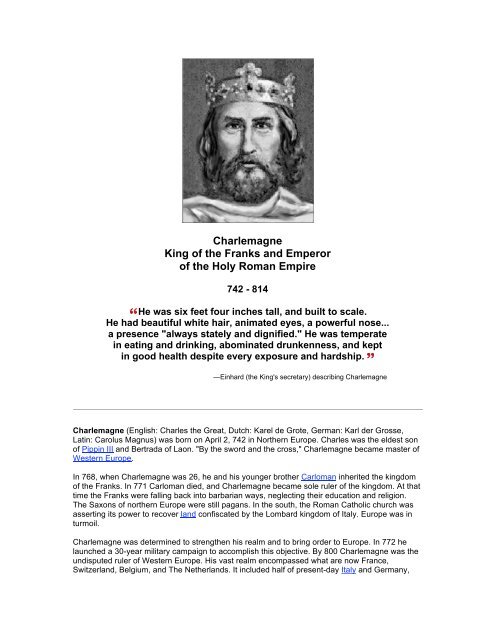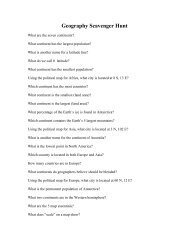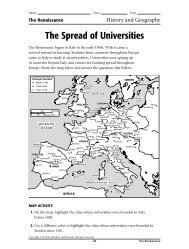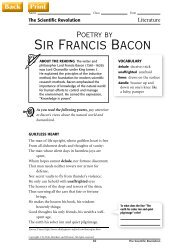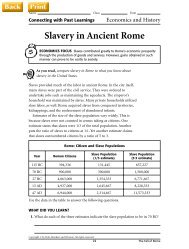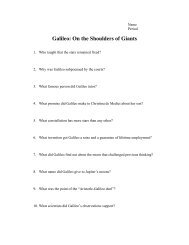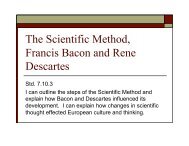Charlemagne Reading - J-blanchard.org
Charlemagne Reading - J-blanchard.org
Charlemagne Reading - J-blanchard.org
You also want an ePaper? Increase the reach of your titles
YUMPU automatically turns print PDFs into web optimized ePapers that Google loves.
<strong>Charlemagne</strong><br />
King of the Franks and Emperor<br />
of the Holy Roman Empire<br />
742 - 814<br />
He was six feet four inches tall, and built to scale.<br />
He had beautiful white hair, animated eyes, a powerful nose...<br />
a presence "always stately and dignified." He was temperate<br />
in eating and drinking, abominated drunkenness, and kept<br />
in good health despite every exposure and hardship.<br />
—Einhard (the King's secretary) describing <strong>Charlemagne</strong><br />
<strong>Charlemagne</strong> (English: Charles the Great, Dutch: Karel de Grote, German: Karl der Grosse,<br />
Latin: Carolus Magnus) was born on April 2, 742 in Northern Europe. Charles was the eldest son<br />
of Pippin III and Bertrada of Laon. "By the sword and the cross," <strong>Charlemagne</strong> became master of<br />
Western Europe.<br />
In 768, when <strong>Charlemagne</strong> was 26, he and his younger brother Carloman inherited the kingdom<br />
of the Franks. In 771 Carloman died, and <strong>Charlemagne</strong> became sole ruler of the kingdom. At that<br />
time the Franks were falling back into barbarian ways, neglecting their education and religion.<br />
The Saxons of northern Europe were still pagans. In the south, the Roman Catholic church was<br />
asserting its power to recover land confiscated by the Lombard kingdom of Italy. Europe was in<br />
turmoil.<br />
<strong>Charlemagne</strong> was determined to strengthen his realm and to bring order to Europe. In 772 he<br />
launched a 30-year military campaign to accomplish this objective. By 800 <strong>Charlemagne</strong> was the<br />
undisputed ruler of Western Europe. His vast realm encompassed what are now France,<br />
Switzerland, Belgium, and The Netherlands. It included half of present-day Italy and Germany,
and parts of Austria and Spain. By establishing a central government over Western Europe,<br />
<strong>Charlemagne</strong> restored much of the unity of the old Roman Empire and paved the way for the<br />
development of modern Europe.<br />
On Christmas Day in 800, while <strong>Charlemagne</strong> knelt in prayer in Saint Peter's in Rome, Pope Leo<br />
III placed a golden crown on the bowed head of the king. <strong>Charlemagne</strong> is said to have been<br />
surprised by the coronation, declaring that he would not have come into the church had he known<br />
the pope's plan. However, some historians say the pope would not have dared to act without<br />
<strong>Charlemagne</strong>'s knowledge.<br />
<strong>Charlemagne</strong> learned to read Latin and some Greek but apparently did not master writing. At<br />
meals, instead of having jesters perform, he listened to visiting scholars read from learned works.<br />
<strong>Charlemagne</strong> believed that government should be for the benefit of the governed. He was a<br />
reformer who tried to improve his subject's lives. He set up money standards to encourage<br />
commerce and urged better farming methods.<br />
"By the sword and the cross," <strong>Charlemagne</strong> became master of Western<br />
Europe<br />
As is often the case, people considered great by historians are great killers as well. Throughout<br />
his conquests, <strong>Charlemagne</strong> was responsible for the death of masses of people who refused to<br />
accept Christianity, or their new king. Choosing to keep faith with their old gods and leaders,<br />
many thousands were slaughtered.


